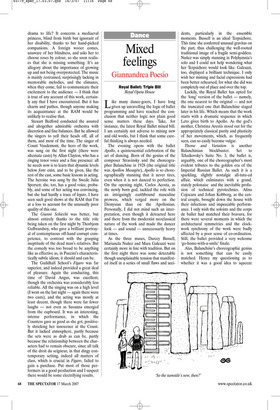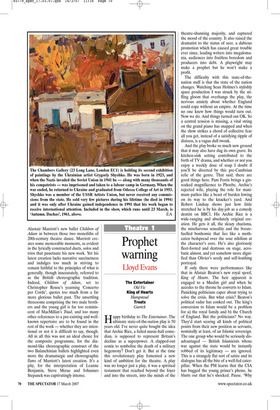Mixed feelings
Giannandrea Poesio
Royal Ballet: Triple Bill
Royal Opera House
Like many dance-goers, I have long given up unravelling the logic of ballet programming and have reached the conclusion that neither logic nor plain good sense matters these days. Take, for instance, the latest Royal Ballet mixed bill. I am certainly not adverse to mixing new and old works, but I think that some careful thinking is always needed.
The evening opens with the ballet Apollo, a quintessential celebration of the art of dancing. Born of the genius of the composer Stravinsky and the choreographer Balanchine in 1928 (the original title was Apollon Musagète), Apollo is so choreographically stunning that it never tires, even when it is not danced to perfection. On the opening night, Carlos Acosta, as the newly born god, tackled the role with an intriguingly earthbound masculine prowess, which verged more on the Dionysian than on the Apollonian. Personally, I did not mind such an interpretation, even though it detracted here and there from the modernist neoclassical nature of the work and made the dancer look — and sound — unnecessarily heavy at times.
As the three muses, Darcey Bussell, Marianela Nuñez and Mara Galeazzi were certainly more in line with tradition. But on the first night there was some detectable though unexplainable tension that manifested itself in a series of small flaws and acci dents, particularly in the ensemble moments. Bussell is an ideal Terpsichore. This time she conferred unusual gravitas on the part, thus challenging the well-rooted traditional image of a fragile semi-goddess. Nuñez was simply stunning in Polyhymnia’s solo and I could not help wondering what her Terpsichore would look like. Galeazzi, too, displayed a brilliant technique. I only wish her miming and facial expressions had been better rehearsed, for what she did was completely out of place and over the top.
Luckily, the Royal Ballet has opted for the ‘long’ version of the ballet — namely, the one nearest to the original — and not the truncated one that Balanchine staged later in his life. Which means that the work starts with a dramatic sequence in which Leto gives birth to Apollo. As the god’s mother, Christina Arestis stood out for the appropriately classical purity and plasticity of her movements, which, as frequently seen, can so easily become vulgar.
Theme and Variation is another Balanchinian blockbuster. Set to Tchaikovsky’s Suite No. 3, the ballet is, arguably, one of the choreographer’s most evident tributes to the golden era of the Imperial Russian Ballet. As such it is a sparkling, slightly nostalgic all-tutu-ed affair, which culminates with a grand, stately polonaise and the inevitable profusion of technical pyrotechnics. Alina Cojocaru and Johan Kobborg, as the central couple, brought down the house with their infectious and impeccable performance. I only wish the soloists and the corps de ballet had matched their bravura, for there were several moments in which the architectural symmetries and the clockwork synchrony of the work were badly affected by a poor sense of co-ordination. Still, the ballet provided a very welcome ‘go-home-with-a-smile’ finale.
Alas, Balanchine’s choreographic genius is not something that can be easily matched. Hence my questioning as to whether it was a good idea to squeeze Alastair Marriott’s new ballet Children of Adam in between those two monoliths of 20th-century theatre dance. Marriott creates some memorable moments, as evident in the lyrically constructed duets, solos and trios that punctuate his new work. Yet his latest creation lacks narrative succinctness and indulges too much in striving to remain faithful to the principles of what is generally, though inaccurately, referred to as the British choreographic tradition. Indeed, Children of Adam, set to Christopher Rouse’s yearning ‘Concerto per Corde’, quotes too much from a far more glorious ballet past. The unsettling threesome comprising the two male brothers and the young girl is far too reminiscent of MacMillan’s Triad, and too many other references to a pre-existing and wellknown repertoire are to be found in the rest of the work — whether they are intentional or not it is difficult to say, though. All in all this was not an ideal choice for the composite programme, for the diamond-like choreographic construct of the two Balanchinian ballets highlighted even more the dramaturgic and choreographic flaws of Marriott’s latest creation. It’s a pity, for the interpretation of Leanne Benjamin, Steve Mcrae and Johannes Stepanek was captivatingly intense.



































































































 Previous page
Previous page